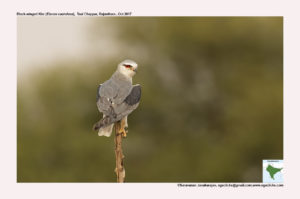
Black Winged Kite Elanus caeruleus
Etymology :
- Elanus : Greek word for Kite
- Caeruleus: Latin word for azure-blue
Vernacular Names : Hindi, Ben: Kapassi, Pun: Chitti, U.P.: Masunwa, Nepal: Chanwa, Guj: Kapasi, Mar: Kapshi Ghar, Te: Adavi ramadasu, Yerkali: Argellur, Mal: Velli-eriyan, Ukussa, Sinh: Kurlla goya
Distribution in India: Resident all over India except upper Himalayas
Description: Size of 33–37 cm; wt. of male 181–300 g, wt. of female 270–365 g; wingspan of 82–94 cm. It is a falcon-like kite with relatively large, rounded head, pointed wings that exceed short tail when perched, notched tail and shallow gull-like wingbeats. The female islarger than male . The irides are red (initially grey-brown in juvenile, then yellow-brown to orange-red), cere is horn or yellow (yellow-horn in juvenile) and legs are bright yellow (yellow-white to pale yellow in juvenile). The juvenile is washed rusty on head and body, with feathers of back and upperwings tipped white, darker shoulders and grey-mottled wings. The Juvenile assumes adult plumage within a few months of fledging, but flight feathers and tail retained until 9–12 months old.
Habitat : It is found in grassland and other sparsely wooded habitats with ground cover including savanna, coastal sand-dunes , tree-lined watercourses, farmland, heath, market gardens and vacant urban grassy land. It is found from sea-level up to 1500 m.
Food Habits: It is a meat eater. It prefers Mice and mice sized prey. It is a very highly skilled hunter and can catch and eat up to 3 mices a day (1000 a year). Thus keeps the rodent population in control. It has a very unique technique for hunting. It hovers above the ground (about 12 meters high) and search for prey. Once the prey is locked, it dives “Feet first”, the prey is caught in the talons and sometimes consumed in flight, else taken to a favoured perch and devoured. The hovering can occur for a few seconds or for few minutes and in stages. (To know how they hover pls visit www.ogaclicks.com/wordpress/science-of-flight/)
Breeding Habits: They breed in the months of August- January depending on availability of prey espl. Mice. The male has to display its flying skills to attract the female, the female will have to be fed in Mid air and then a ritual talon grappling happens. Once the female has chosen its partner, they are monogamous for the breeding period. Both partners build the nest together, it is a large shallow cup of sticks usually in the foliage near the top of trees. The nest building continues even after the hatching of chicks to provide for the extra room. Also the reused nests when refurbished become larger and deeper. The nest is lined with green leaves and felted fur, linings of grass and cow dung. Black-shouldered kites have been known to use old magpie, crow or raven nests. They lay 3-4 eggs and incubation is primarily the role of female. The male gets food for the female and the chicks for the first few weeks from hatching. The incubation period is 30 days. The chicks are Altricial with closed eyes and some down feathers. The female leaves the nest after 3 weeks to also provide for food as the chicks get bigger. The chicks stay in the nest for 36 days at least and the post fledging period is also about 35 days with the chicks being fed by parents for at least 20 odd days during this period.
This is one of the most common birds to be seen on electrical poles or wires on the highways.